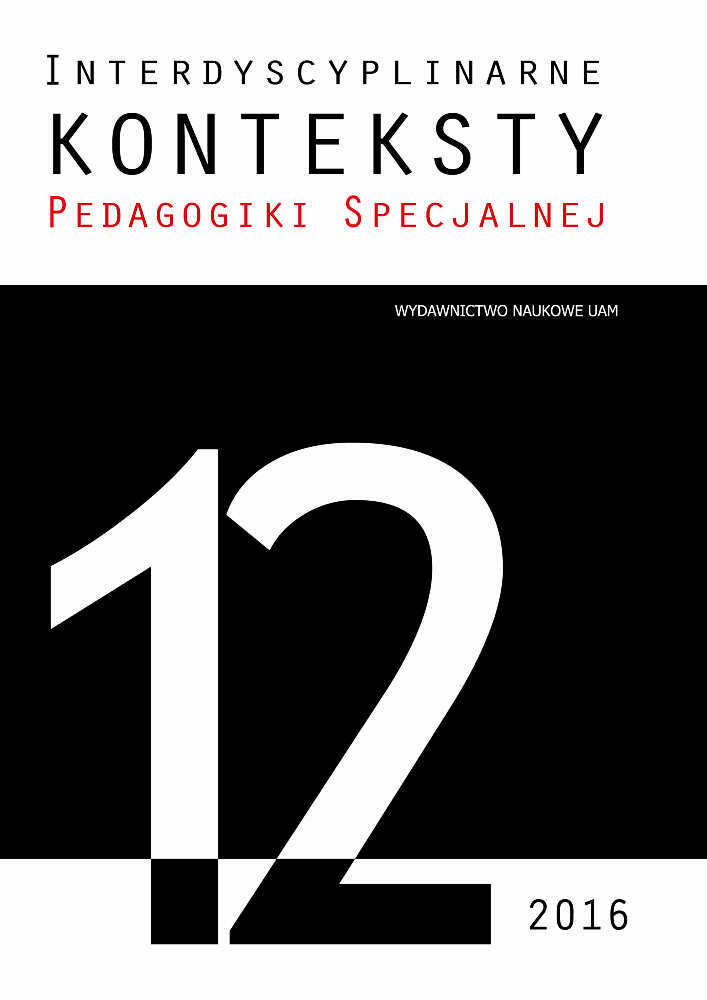Abstrakt
The purpose of this article is to show the possibility of using conductive education system and its effectiveness in working with children and young people with profound intellectual disabilities attending rehabilitation – educational groups, in order to develop and form their self-reliance, and the grounds of autonomy. In the first part of text the author described the functioning of people with profound intellectual disabilities, pointing to their specific difficulties in the field of independent functioning. Then author showed the assumptions of conductive education system with regard to the objectives set by The Ministry of Education for rehabilitation-educational classes.
Using of the possibilities inherent in the monographic method, the author presented rehabilitation-educational activities with the use of conductive education method, with particular attention to the aspects of the development of autonomy of children and young people with profound intellectual disabilities. The data for analysis and description was collected through the observation (direct, participatory and indirect – by video camera) of participants of rehabilitation – educational activities (15 persons), analysis of documentation (observation sheets and individual curriculums) and interviews with teachers of three rehabilitation – educational groups.
Although it is difficult to determine the actual impact of Petö method on increase of self-reliance and autonomy of children and young people with profound intellectual disabilities, the collected information indicates the importance of the conductive education method – particularly in aspects of socialization, communication and agility.
Bibliografia
Anttila H., Suoranta J., Malmivaara A., Mäkelä M., Autti-Rämö I., Effectiveness of physiotherapy and conductive education interventions in children with cerebral palsy: a focused review, “American Journal of Physical Medicine & Rehabilitation” 2008, t. 87, nr 6.
Apanowicz J., Metodologia ogólna, Bernardinum, Gdynia 2002.
Chrzanowska I., Pedagogika specjalna. Od tradycji do współczesności, Oficyna Wydawnicza „Impuls”, Kraków 2015.
Cytowska B., Drzazga A., Znaczenie i wykorzystanie komunikacji wspomagającej i alternatywnej (AAC) w porozumiewaniu się z osobami z głęboką niepełnosprawnością intelektualną, [w:] Dzieci o specjalnych potrzebach komunikacyjnych. Diagnoza – edukacja – terapia, red. B. Winczura, Oficyna Wydawnicza „Impuls”, Kraków 2013.
Forrai J., History of a Special Healing Method for Motordisordered Children: Conductive Education, “Communicationes de Historia Artis Medicinae”, Suplement: 200–2001, 2007.
Fröhlich A., Stymulacja od podstaw. Jak stymulować rozwój osób głęboko wielorako niepełnosprawnych, WSiP, Warszawa 1998.
Jankiewicz A., Skrypnik D., Skrypnik K., Głęboka niepełnosprawność intelektualna a rozwój emocjonalno-społeczny i motoryczny, „Psychiatria” 2014, tom 11, nr 4.
Kościelska M., Oblicza upośledzenia, PWN, Warszawa 1998.
Pilch T., Bauman T., Zasady badań pedagogicznych. Strategie ilościowe i jakościowe, Wydawnictwo Żak, Warszawa 2001.
Rozporządzenie Ministra Edukacji Narodowej z dnia 23 kwietnia 2013 r. w sprawie warunków i sposobu organizowania zajęć rewalidacyjno-wychowawczych dla dzieci i młodzieży z upośledzeniem umysłowym w stopniu głębokim (Dz.U. z 7 maja 2013, poz. 529).
Sztumski J., Wstęp do metod i technik badań społecznych, Wydawnictwo Śląsk, Katowice 2005.
Topolski J., Problemy metodologiczne badań wsi, [w:] Badania empiryczne w socjologii, tom II, red. M. Malikowski, M. Niezgoda, Tyczyn 1997.
Witkowski T., Podręcznik do Inwentarza PPAC H.C. Gunzburga do oceny postępu w rozwoju społecznym (osób z upośledzeniem umysłowym), COMPWZ MEN, Warszawa 1988.
Źródła internetowe
Beck F., Remembering András Pető, 2nd International Conference for Theory and Practice in Education,http://www.tsadkadima.org.il/_Uploads/dbsAttachedFiles/Remebering_Peto(3).pdf [20.05.2016].
Darrah J., Watkins B., Chen L., Bonin C., Effects of Conductive Education Intervention for Children with a Diagnosis of Cerebral Palsy, An AACPDM Evidence Report; http://www.aacpdm.org/UserFiles/file/conductive-education.pdf [20.05.2016].
Gegenwarth T. (ed.), Handbook Conductive Education. Together, Constructive, Conductive – Adult learners in Complex Rehabilitation, European Association of Conductive Education and Professional Practice (ECA), 2012, http://www.movewalk.se/Portals/0/Handbook_Grundtvig_Final%20Version.pdf [30.05.2016].
Wądołowska B., Kierowane nauczanie – edukacyjne rozwiązanie problemu medycznego, „BIULETYN SIECI MPD”, nr 4; http://www.spdn.pl/Biuletyny,a,32.html [10.05.2016].
Zhang Z., Bowens A., Bennet S., Effectiveness of conductive education for cerebral palsy, “Evidence Based Review” 2003, www.Conductive Education for Cerebral Palsy (PDF 292K) - October 2003 (1).pdf [10.05.2016].
